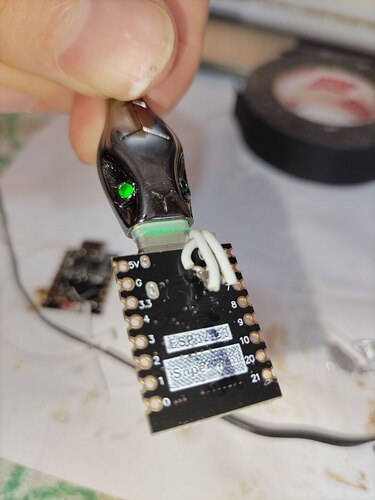My AP is a 50cm away and supports both 2.4 and 5.0GHz.
I had doubts if Wifi really works on that module, so I tested it in VS Code with ESP-IDF extension and built a wlan station application. It works, he're the terminal output (I edited secrets to xxxxxx):
....
I (471) phy_init: phy_version 1180,01f2a49,Jun 4 2024,16:34:25
I (521) wifi:mode : sta (48:ca:43:da:e3:cc)
I (521) wifi:enable tsf
I (521) wifi station: wifi_init_sta finished.
I (681) wifi:new:<1,0>, old:<1,0>, ap:<255,255>, sta:<1,0>, prof:1, snd_ch_cfg:0x0
I (681) wifi:state: init -> auth (0xb0)
I (1681) wifi:state: auth -> init (0x200)
I (1681) wifi:new:<1,0>, old:<1,0>, ap:<255,255>, sta:<1,0>, prof:1, snd_ch_cfg:0x0
I (1681) wifi station: retry to connect to the AP
I (1681) wifi station: connect to the AP fail
I (1731) wifi:new:<11,0>, old:<1,0>, ap:<255,255>, sta:<11,0>, prof:1, snd_ch_cfg:0x0
I (1731) wifi:state: init -> auth (0xb0)
I (1741) wifi:state: auth -> init (0x8a0)
I (1741) wifi:new:<11,0>, old:<11,0>, ap:<255,255>, sta:<11,0>, prof:1, snd_ch_cfg:0x0
I (1741) wifi station: retry to connect to the AP
I (1751) wifi station: connect to the AP fail
I (4151) wifi station: retry to connect to the AP
I (4151) wifi station: connect to the AP fail
I (4161) wifi:new:<11,0>, old:<11,0>, ap:<255,255>, sta:<11,0>, prof:1, snd_ch_cfg:0x0
I (4161) wifi:state: init -> auth (0xb0)
I (4171) wifi:state: auth -> assoc (0x0)
I (4191) wifi:state: assoc -> run (0x10)
I (4251) wifi:connected with xxxxx, aid = 1, channel 11, BW20, bssid = 44:4e:6d:3f:e2:ca
I (4251) wifi:security: WPA2-PSK, phy: bgn, rssi: -54
I (4261) wifi:pm start, type: 1
I (4261) wifi:dp: 1, bi: 102400, li: 3, scale listen interval from 307200 us to 307200 us
I (4271) wifi:set rx beacon pti, rx_bcn_pti: 0, bcn_timeout: 25000, mt_pti: 0, mt_time: 10000
I (4301) wifi:AP's beacon interval = 102400 us, DTIM period = 1
I (4311) wifi:<ba-add>idx:0 (ifx:0, 44:4e:6d:3f:e2:ca), tid:6, ssn:2, winSize:64
I (5781) esp_netif_handlers: sta ip: 192.168.3.140, mask: 255.255.255.0, gw: 192.168.3.1
I (5781) wifi station: got ip:192.168.3.140
I (5781) wifi station: connected to ap SSID:xxxxxx password:xxxxxx
I (5791) main_task: Returned from app_main()






